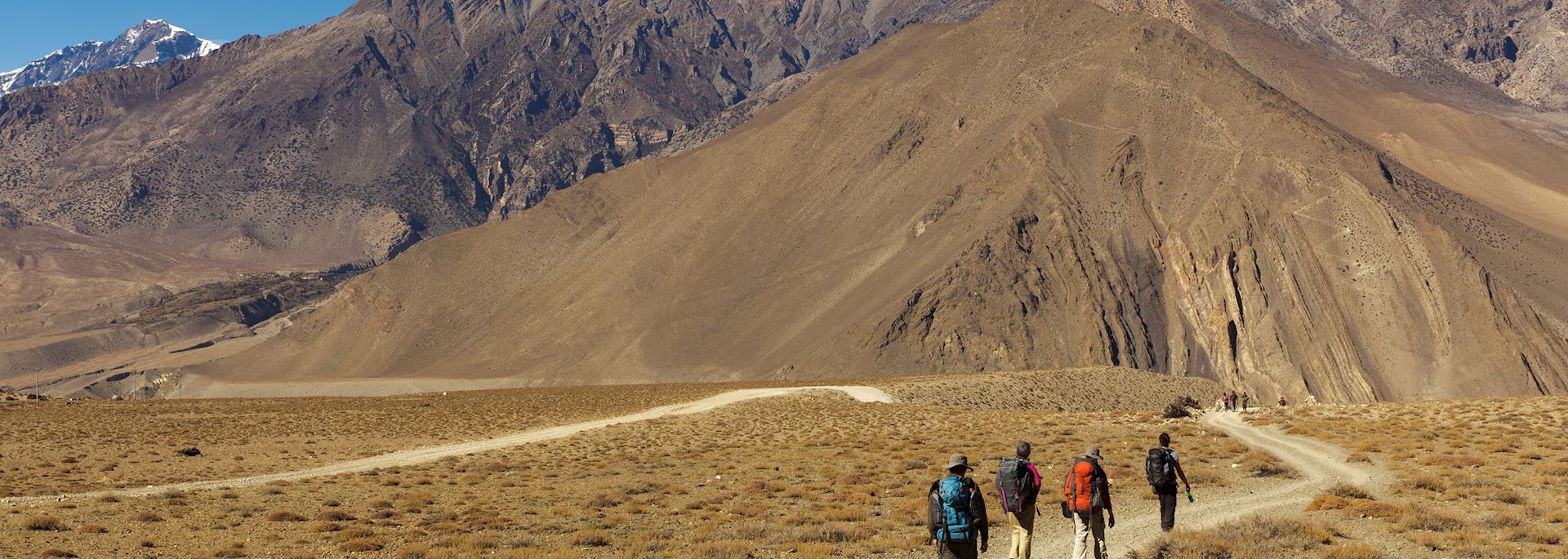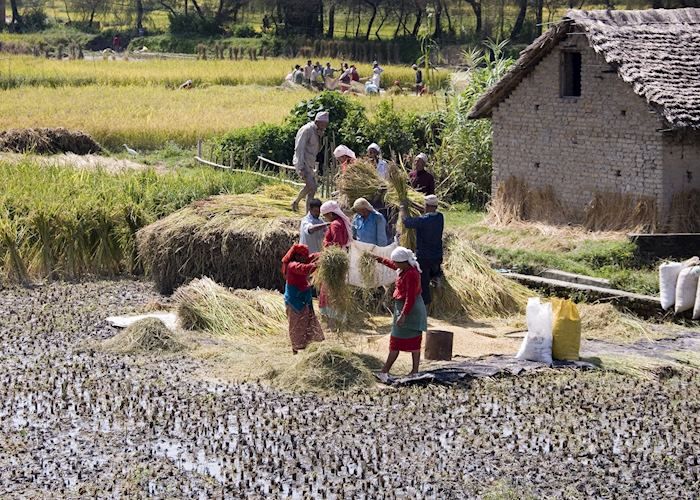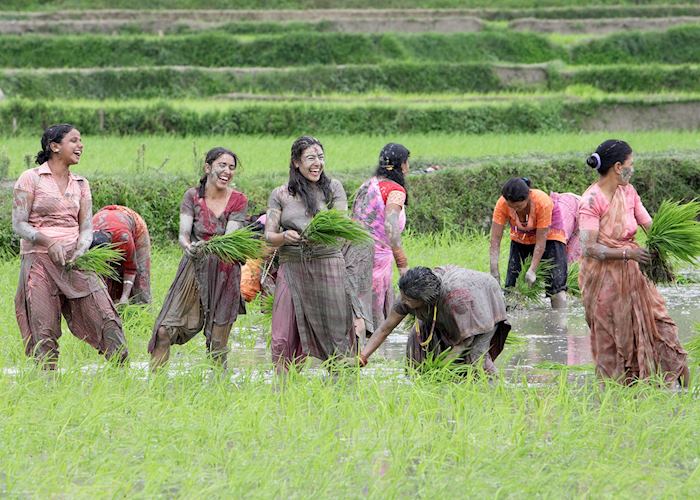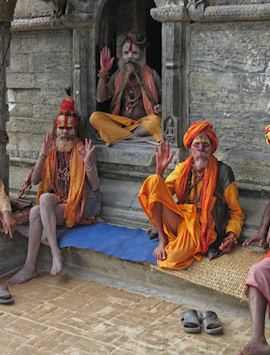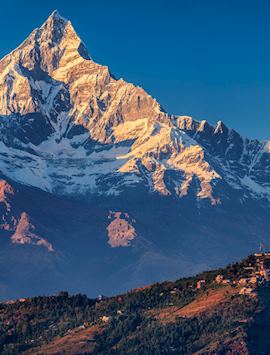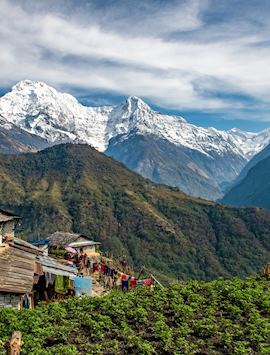
Only 20% of Nepal is accessible by road. If you want to see the rest of the country, you’ll need to go trekking. The exact nature of your personal trek will depend on what you’re looking for — each route and guide is chosen specifically for you. Here, we’ve outlined a handful of the options available in Annapurna, our preferred region for trekking. But please speak to your specialist if you’re interested in trekking elsewhere in Nepal.
A subrange of the Himalaya, this area northwest of Kathmandu is less popular than the Everest region, with fewer walkers. You'll also find more variety, with treks passing fertile foothills, farms, and forest before reaching glaciers and mountains. Each valley shelters a community that’s exceptionally welcoming, from farmers to monks. Plus, you’ll still find peaks over 8,000 m (26,246 ft).
Trekking to Poon Hill in Nepal
If you’re looking for something a little more challenging, and like having a target to aim for, consider trekking to Poon Hill. The five-night trek starts from Pokhara and climbs up well-paved deep steps and through tree-lined valleys until you reach the summit of Poon Hill. At 3,200 m (10,498 ft), its modest name doesn’t quite do it justice. At the summit, the full Annapurna range is spread out in front of you like a geographic illustration — you can see every peak.
En route, you’ll spend the first few nights in luxurious lodges. Climbing higher, you’ll stay in tea lodges. The rooms at these traditional mountain inns are private and comfortable, but you’ll share a bathroom. Evenings are spent with your fellow guests around the fire.
Trekking to Annapurna Base Camp
The real challenge of the Annapurna range is trekking to Annapurna Base Camp. The combination of the high altitude and steep tracks makes it one of the toughest treks in the region, but many consider the scenery worth it.
The trek takes two weeks, starting in Pokhara and heading ever up from there. The first few days are vibrant, as you pass busy hamlets, farmers tending to their rice fields, and expanses of rhododendron bushes, which are covered with deep pink flowers in late spring. Heading into thick bamboo forest, you might spot rare orchids and ferns, too.
Eventually, you'll reach the Annapurna Sanctuary. The Sanctuary is an isolated basin surrounded by a ring of some of Nepal’s highest peaks, creating a natural amphitheatre for Himalayan scenery. The canyon is the only way into the basin with a small trailside shrine marking the path into the sanctuary.
After a night in a tea lodge, make your final climb to Annapurna Base Camp at 4,100 m (13,451 ft). Along the way, you'll pass Machhapuchhre Base Camp, which is used by climbers attempting Annapurna’s south col. Machhapuchhre itself is a sacred mountain and its trails are closed to climbers.
The Annapurna Base Camp is built on a rocky patch just beyond the Annapurna South Glacier. A collection of small tin-roof buildings and a hand-painted welcome sign greet you. Looking up, you’ll be encircled by a 360-degree panorama of serrated peaks. The highest, Annapurna I is the world’s tenth-highest peak at 8,091 m (26,545 ft) and one of the most dangerous to climb.
Luxury trekking in Annapurna
If you’re unsure about tackling an epic trek and foregoing your access to hot water, there are gentler options. In the foothills of the Annapurna, there’s a network of lodges that are much more luxurious than a traditional tea house. You won’t get a hot tub or marble bathtub, but you will get tea brought to you each morning, an en suite room, and hot water — real luxuries when staying in the mountains.
After a short drive from Pokhara, you’ll be able to start walking to your first lodge, accompanied by a private guide and porter. Trekking along the main village tracks, you’ll pass children on their way to school and local people carrying a startling variety of goods.
You can choose from a variety of routes, picking the duration and difficulty level. Trekking between lodges, you’re unlikely to climb higher than 2,000 m (6,561 ft), but the Annapurna’s crisp white peaks are always in sight.
When is the best time to trek in Nepal?
October and November are the best months to trek in Nepal, with the clearest skies and comfortable daytime temperatures, though the highest altitudes are around freezing.
December and January can see chilly nights on the lower-altitude trails and around the luxury lodges, and freezing temperatures on Poon Hill. In February and March, the temperatures rise again, and the visibility is good. If you’re willing to encounter a few showers in April and early May, you may be rewarded with spring flowers like rhododendrons in full bloom.
who's been there
-
01993 838 92501993 838 315
- Make an enquiry
Photos of Nepal trekking in Annapurna
Experience it for yourself
You can enjoy this activity as part of the suggested tours below, or we can weave it into a trip shaped entirely around you.

